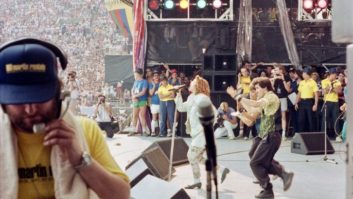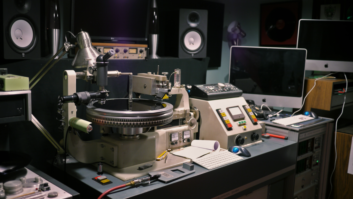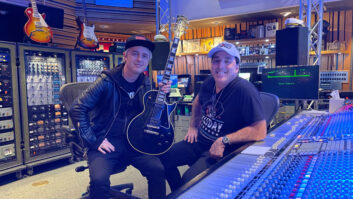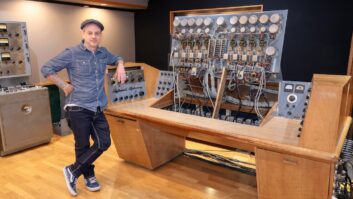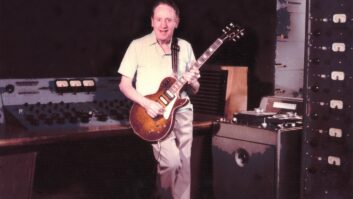
Nashville, TN (February 5, 2021)—Necessity was the mother of reinvention when Nashville recording and mastering facility Welcome to 1979’s yearly recording summit rolled around in November. Faced with canceling the twelfth annual event in the face of the coronavirus pandemic, the organizers elected to move everything online.
The three-day event typically maxes out at 60 in-person attendees, according to co-owner Chris Mara, who opened the facility with his wife, Yoli, in 2008. “What’s said here stays here; we don’t record any of it,” he says, other than the first night’s direct-to-vinyl live recording session. In past years, guest artists have included Old Crow Medicine Show and Jason Isbell.
Mara, his wife and a third partner, Lori Hines, who runs the company’s electroplating business, started researching online alternatives in June and discovered the Whova virtual event management platform. In combination with Zoom videoconferencing, the platform allowed them to retain the all-important recording session, enabled panelists who might otherwise not have been available to travel to simply log in and participate, and put a new spin on the presentations.

For example, says Mara, they had originally planned to showcase different miking techniques with multiple drummers and their kits in Welcome to 1979’s studio. The virtual event “allowed Butch Walker, Chris Garges and Ryan Freeland to Zoom in and show us their drum setups from different parts of the country; it was fantastic,” he says.
“We had a lot of technical rehearsals ahead of time,” Mara also reports. “There isn’t a lot of accurate information out there about how to do this, and we had to make everything bulletproof.”
Review: Mara Machines MCI JH-110C 1/4-Inch 2-Track Recorder
The traditional Friday night session transitioned to a live-to-vinyl-to-Zoom event featuring Southern rockers Blackberry Smoke, augmented to an 11-piece, recording four Rolling Stones covers per side. “It went from our console to our lathe. We took a lathe output to two Pro Tools tracks, open on input, that fed audio to Zoom. For cameras, we had four iPhones on Zoom,” he says.
Jeremy Bernstein mixed the session, assisted by Nick Molino. Margaret Luthar mastered the project live to vinyl with assistance from Anna Clark.

Whova enables virtual meetups, mimicking the annual event’s after-hours hangs. At the wrap-up hang, says Mara, “I was prepared for attendees to demand their money back.” Instead, he says, everyone was enthusiastic about incorporating some of the new features into future summits.
“Now we know how to do this online,” says Mara. “After we wrapped up, I said, ‘No matter what 2021 brings, we’re ready.’”
In researching how best to host the event virtually, Mara says, he came across a lot of bad advice that would have detracted from the summit’s usual appeal. “We did plant some stakes in the ground. We weren’t going to give up our Friday night party. So we said, ‘We’re going to keep the price the same, limit it to 60 people still, and we’re going to do eight hours a day’—and we sold out.”
Panelists included a who’s who of recording and mastering engineers, including Andrew Sheps, Eric Valentine, Larry Crane, Kim Rosen, Jessica Thompson, J.J. Blair, Pete Lyman and Jason Orris. “How Records Are Made: Top to Bottom,” following the process from vinyl mastering and electroplating in Nashville to Hand Drawn Pressing in Dallas, TX, featured each presenter virtually handing over the lacquer to the next person. “Halfway through, we said, ‘We should be recording this,’” says Mara.

Welcome to 1979, with a total floor area of about 13,000 square feet, was able to easily accommodate Blackberry Smoke’s expanded lineup. Drums, percussion, bass, guitars and keyboards were in the main room, with lead vocalist/guitarist Charlie Starr in an iso booth. “I tracked a record last year where the band had a percussionist and I found that the closer they were to the drum kit, the better they sounded. Almost everyone was physically in the same room with their amps in amp rooms,” says Mara.
“We put the two backgrounds singers in the entryway between the singer and the band, visually. The two horns were in a 1970s dead room that we have right behind the drums, so they could see everyone, too. It was a really good vibe.”
Welcome to 1979 • www.welcometo1979.com


